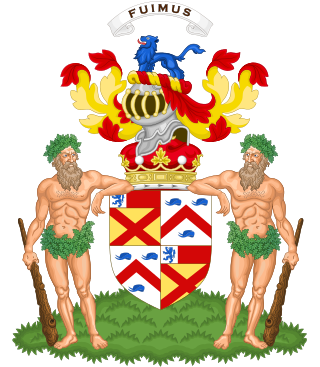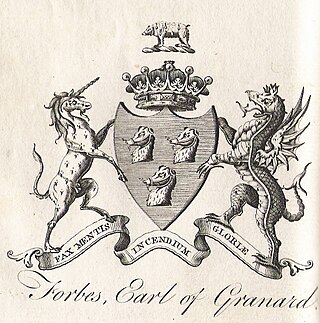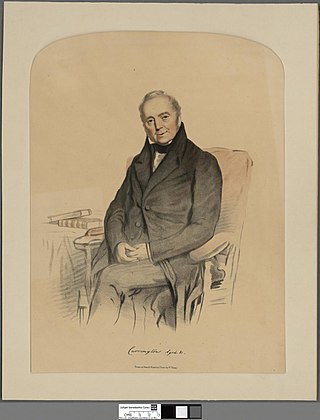
Duke of Atholl, named for Atholl in Scotland, is a title in the Peerage of Scotland held by the head of Clan Murray. It was created by Queen Anne in 1703 for John Murray, 2nd Marquess of Atholl, with a special remainder to the heir male of his father, the 1st Marquess.

Marquess Camden is a title in the Peerage of the United Kingdom. It was created in 1812 for the politician John Pratt, 2nd Earl Camden. The Pratt family descends from Sir John Pratt, Lord Chief Justice from 1718 to 1725. His third son from his second marriage, Sir Charles Pratt, was also a prominent lawyer and politician and served as Lord Chancellor between 1766 and 1770. In 1765 he was raised to the Peerage of Great Britain as Baron Camden, of Camden Place in the County of Kent, and in 1786 he was further honoured when he was created Viscount Bayham, of Bayham Abbey in the County of Kent, and Earl Camden. These titles are also in the Peerage of Great Britain. Lord Camden was married to Elizabeth, daughter of Nicholas Jeffreys, of The Priory, Brecknockshire, in Wales.

Marquess of Cholmondeley is a title in the Peerage of the United Kingdom. It was created in 1815 for George Cholmondeley, 4th Earl of Cholmondeley.

Marquess of Ailesbury, in the County of Buckingham, is a title in the Peerage of the United Kingdom. It was created on 17 July 1821 for Charles Brudenell-Bruce, 2nd Earl of Ailesbury.

Earl of Rothes is a title in the Peerage of Scotland. It was created in 1458 for George Leslie, 1st Lord Leslie. He had already been created Lord Leslie in 1445, also in the Peerage of Scotland. His grandson, the third Earl, having only succeeded his elder brother in March 1513, was killed at the Battle of Flodden on 9 September of the same year. His son, the fourth Earl, served as an Extraordinary Lord of Session. Lord Rothes was also tried for the murder of Cardinal Beaton but was acquitted.

Earl of Haddington is a title in the Peerage of Scotland. It was created in 1627 for the noted Scottish lawyer and judge Thomas Hamilton, 1st Earl of Melrose. He was Lord President of the Court of Session from 1616 to 1625. Hamilton had already been created Lord Binning in 1613 and Lord Binning and Byres, in the County of Haddington, and Earl of Melrose, in the County of Roxburgh, in 1619. These titles were also in the Peerage of Scotland. The title of the earldom derived from the fact that he was in possession of much of the lands of the former Melrose Abbey. However, Hamilton was unhappy with this title and wished to replace it with "Haddington". In 1627 he relinquished the earldom of Melrose and was instead created Earl of Haddington, with the precedence of 1619 and with limitation to his heirs male bearing the surname of Hamilton. This derived from the fact that he considered it a greater honour to take his title from a county rather than from an abbey. Hamilton was a member of the prominent Scottish family of that name and descended from John de Hamilton, younger son of Walter de Hamilton, who was granted the feudal barony of Cadzow and who is also the ancestor of the Dukes of Hamilton and Dukes of Abercorn.

Earl Bathurst, of Bathurst in the County of Sussex, is a title in the Peerage of Great Britain.

Earl Lloyd-George of Dwyfor is a title in the peerage of the United Kingdom. It was created in 1945 for Liberal parliamentarian David Lloyd George who served as Chancellor of the Exchequer from 1908 to 1915 and Prime Minister of the United Kingdom from 1916 to 1922. He was created Viscount Gwynedd, of Dwyfor in the County of Caernarvon, also in the peerage of the United Kingdom, at the same time.

Earl of Granard is a title in the Peerage of Ireland. It was created in 1684 for Arthur Forbes, 1st Viscount Granard. He was a lieutenant-general in the army and served as Marshal of the Army in Ireland after the Restoration and was later Lord Justice of Ireland. He had already succeeded his father as second Baronet of Castle Forbes and been created Baron Clanehugh and Viscount Granard in 1675, also in the Peerage of Ireland. The baronetcy, of Castle Forbes in county Longford, was created in the Baronetage of Nova Scotia on 29 September 1628 for his father, Arthur Forbes.

Earl Erne, of Crom Castle in the County of Fermanagh, is a title in the Peerage of Ireland. It was created in 1789 for John Creighton, 2nd Baron Erne, who had earlier represented Lifford in the Irish House of Commons. He had already been made Viscount Erne, of Crom Castle in the County of Fermanagh, in 1781, also in the Peerage of Ireland, and sat from 1800 to 1828 as an Irish Representative Peer in the British House of Lords. The title of Baron Erne, of Crom Castle in the County of Fermanagh, was created in the Peerage of Ireland in 1768 for his father Abraham Creighton. The Earl was succeeded by his eldest son, the second Earl. On his death the titles passed to his nephew, the third Earl. He was an Irish Representative Peer from 1845 to 1885 and also served as Lord Lieutenant of County Fermanagh during the same period. In 1876 he was created Baron Fermanagh, of Lisnaskea in the County of Fermanagh, in the Peerage of the United Kingdom. This was to allow the Earls to sit in the House of Lords by right, rather than having to stand for election as Representative Peers. An earlier title of Baroness Fermanagh in the Peerage of Ireland was created for Mary Verney on 13 June 1792, but became extinct on her death on 15 November 1810.

Earl of Onslow, of Onslow in the County of Shropshire and of Clandon Park in the County of Surrey is a title in the Peerage of the United Kingdom. It was created in 1801 for George Onslow, 4th Baron Onslow.

Earl of Selborne, in the County of Southampton, is a title in the Peerage of the United Kingdom. It was created in 1882 for the lawyer and Liberal politician Roundell Palmer, 1st Baron Selborne, along with the subsidiary title of Viscount Wolmer, of Blackmoor in the County of Southampton. He had already been made Baron Selborne, of Selborne in the County of Southampton, in 1872, also in the Peerage of the United Kingdom. Both his son, the second Earl, and grandson, the third Earl, were prominent Liberal Unionist politicians. The latter was in 1941 called to the House of Lords through a writ of acceleration in his father's barony of Selborne. The third Earl's grandson, the fourth Earl, served as one of the ninety elected hereditary peers that remain in the House of Lords after the passing of the House of Lords Act 1999, and sat as a Conservative. As of 2021, the titles are held by the latter's son, the fifth earl, who succeeded his father in that year.

Viscount Bledisloe, of Lydney in the County of Gloucestershire, is a title in the Peerage of the United Kingdom. It was created in 1935 for the Conservative politician Charles Bathurst, 1st Baron Bledisloe, upon his retirement as Governor-General of New Zealand. He had already been created Baron Bledisloe, of Lydney in the County of Gloucestershire, in 1918, also in the Peerage of the United Kingdom. Bathurst was the great-grandson and namesake of the early-19th-century politician Charles Bathurst. The latter was the son of Charles Bragge and Anne Bathurst, granddaughter of Sir Benjamin Bathurst, younger brother of Allen Bathurst, 1st Earl Bathurst. In 1804, Charles Bathurst assumed the surname of Bathurst in lieu of Bragge. The first Viscount's grandson, third Viscount, was one of the ninety elected hereditary peers that were allowed to remain in the House of Lords after the passing of the House of Lords Act 1999, and sat as a crossbencher until his death. He was also a member of the Lords Constitution Committee. As of 2017 the titles are held by his son, the fourth Viscount, who succeeded in 2009.

Baron Carrington is a title that has been created three times, once in the Peerage of England, once in the Peerage of Ireland and once in the Peerage of Great Britain.

Baron Ampthill, of Ampthill in the County of Bedfordshire, is a title in the Peerage of the United Kingdom. It was created on 11 March 1881 for the diplomat Lord Odo Russell. He was the third son of Major-General Lord George Russell, second son of John Russell, 6th Duke of Bedford.

William Lloyd George, 3rd Viscount Tenby, JP, was a British peer and army officer. A grandson of the Prime Minister David Lloyd George, he was among the 90 hereditary peers elected to remain in the House of Lords after the passing of the House of Lords Act 1999.

Earl of Carrick, in the barony of Iffa and Offa East, County Tipperary, is a title in the Peerage of Ireland.
Owen Lloyd George, 3rd Earl Lloyd-George of Dwyfor, was a British peer. He sat as a crossbencher in the House of Lords.

Earl of Arran is a title in the Peerage of Ireland. It is not to be confused with the title Earl of Arran in the Peerage of Scotland. The two titles refer to different places: the Aran Islands in Ireland, and the Isle of Arran in Scotland. The Irish earldom is held by the Gore family. The Scottish earldom is a separate title, held as a subsidiary title of the Duke of Hamilton.
David Lloyd George, 2nd Viscount Tenby was a Welsh peer, a grandson of the first David Lloyd George, British prime minister.













